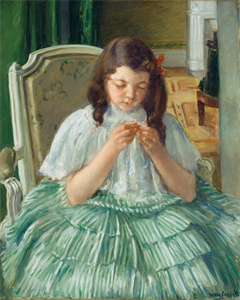Object Results
| Showing 1 of 1 |
|

Frederick Warren Freer
American, 1849–1908
When Freer came to study at the Munich Academy in 1877, the most influential painter in the city was Wilhelm Liebl (German, 1844-1900). Liebl was considered the most stylistically advanced and talented painter in the art community, influenced by German traditions of realist art and the modern works by the French Realists such as Gustave Courbet (1819-1877). This small painting by Freer reflects Liebl’s aesthetic interest in German Renaissance painters' controlled application of paint to reduce the appearance of brushstrokes, which produced a uniform surface texture that resulted in a heightened sense of realism.
Students at the Royal Academy painted many “study heads,” through which they would learn to model form and create flesh tones. In "Girl with White Collar", Freer applied himself to a number of lessons, mimicking the costumes, style, and materials of the old masters. Like them he chose to paint on a wooden panel, rather than on the canvas more typical of his own day, and he applied the paint in narrow, compact strokes that are blended to form a smooth, polished surface. A strong light shines from the left side of the painting, modeling the face through a gradation of tones that imparts a sense of radiant vitality.
American Paintings from the Montgomery Museum of Fine Arts, 2006, cat. no. 27, p. 86.
American, 1849–1908
Girl with White Collar
1877–1880
Object Type:
Painting
Dimensions:
8 1/4 in. x 6 1/4 in. (20.96 cm x 15.88 cm)
Medium and Support:
Oil on wood panel
Accession Number:
1936.0051
Credit Line:
Gift of Mrs. Margaret Freer
Currently On View
When Freer came to study at the Munich Academy in 1877, the most influential painter in the city was Wilhelm Liebl (German, 1844-1900). Liebl was considered the most stylistically advanced and talented painter in the art community, influenced by German traditions of realist art and the modern works by the French Realists such as Gustave Courbet (1819-1877). This small painting by Freer reflects Liebl’s aesthetic interest in German Renaissance painters' controlled application of paint to reduce the appearance of brushstrokes, which produced a uniform surface texture that resulted in a heightened sense of realism.
Students at the Royal Academy painted many “study heads,” through which they would learn to model form and create flesh tones. In "Girl with White Collar", Freer applied himself to a number of lessons, mimicking the costumes, style, and materials of the old masters. Like them he chose to paint on a wooden panel, rather than on the canvas more typical of his own day, and he applied the paint in narrow, compact strokes that are blended to form a smooth, polished surface. A strong light shines from the left side of the painting, modeling the face through a gradation of tones that imparts a sense of radiant vitality.
American Paintings from the Montgomery Museum of Fine Arts, 2006, cat. no. 27, p. 86.
Keywords
Click a term to view the records with the same keyword
Portfolio List
Click a portfolio name to view all the objects in that portfolio
This object is a member of the following portfolios:
Your current search criteria is: Keyword is "RR" and [Object]Century is "Nineteenth Century" and [Object]Nationality is ".
